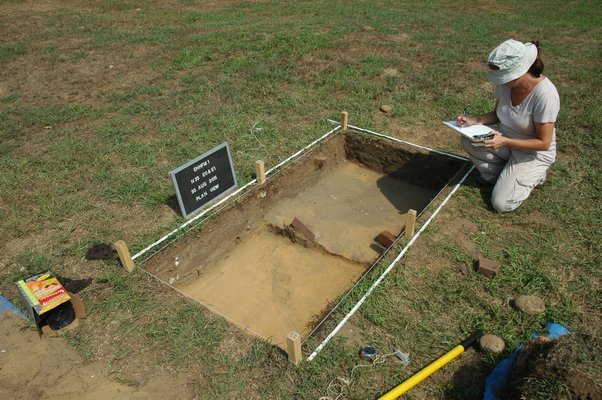
Experts have started to excavate a site in East Hampton that could end up on the National Register of Historic Places. Located on the corner between Cedar Street and North Main Street, the former “commons”—now the headquarters of the East Hampton Historical Farm Museum—may also be the site of one of only three wind-powered sawmills known to have existed in the United States. According to Robert Hefner, an East Hampton historical preservation consultant and author of “The Windmills of Long Island,” these types of mills are particular to the East End of Long Island.
“I’ve never heard of another [region] in America with a wind-powered sawmill,” said Mr. Hefner, who went on to say that there was also a simple one on Gardiner’s Island as well as in Water Mill. There are reports of some in the United Kingdom and Scandinavia as well.
However, finding remnants of the mill may prove difficult, as wood deteriorates over time. Additionally, Dr. Allison McGovern, the archaeologist leading excavations at the site, says that often, when a structure was no longer necessary, its wood would be repurposed, as the material was scarce in the 18th and 19th centuries.
“We found clues that would lead us to investigate further,” said Dr. McGovern, who has been conducting exploratory excavations this summer. After the first round of digging, she is now analyzing the findings. Since remains of the actual mill might prove elusive, the team is also looking for the remains of a stone foundation.
The East Hampton Historical Farm Museum is funding this part of the project through its own initiatives, and it needs to raise $4,000 more by the end of October. Using information garnered from the first few digs, Dr. McGovern will then apply for grants to continue the excavation. She said she feels confident that grants will be awarded due to the “educational value” of the project.
“What we learn about the history should be open to the public,” said Dr. McGovern, whose doctoral dissertation at City University of New York was focused on Montaukett Indians and African-Americans who lived in Freetown area of East Hampton and in Montauk. As someone who is interested in the emergence of the working class, she said, “I hope that what we find is more inclusive.”
“They would have had a labor class of people going to the sawmill, blacksmith, [or] grazing animals,” said Dr. McGovern. Part of the appeal of the project for the East Hampton Historical Farm Museum is the site’s former use as a commons, where many different socio-economic classes would interact.
“I and another woman came up with an idea of a farming museum on 1900s, but we knew this mill was sitting here,” said Prudence Carabine, a co-founder of the museum and president of its board of directors.
This is the first year that the East Hampton Historical Farm Museum has been in operation, on land purchased by East Hampton Town using the Community Preservation Fund. Although the museum’s founders did not choose the site exclusively because it may contain remains of the Dominy Mill, “we knew this was unique,” Ms. Carabine said.
“The fact is, we had Bonackers, Bubs and blacks,” said Ms. Carabine, of the crossroads that existed near the commons. People who continued up the road would reach Freetown, which was founded by freed slaves said to have emigrated from Gardiners Island in the early 1800s. Montaukett Indians also settled in the area.
“It was a big open common, like Southampton Main Street, essentially a big open highway,” said Mr. Hefner, who added that, at some point, Nathaniel Dominy assumed ownership of the land. The wind-powered sawmill was owned collectively by eight people, but eventually Mr. Dominy came to own that as well. “At a certain point in history, these parcels had no value,” Mr. Hefner explained. The land was sold to Selah Lester in 1874.
“I am looking at it from the upstreet and downstreet angle,” said Dr. McGovern, referring to the two historically distinct socio-economic geographical areas of East Hampton. “There was extreme wealth in the village,” said Dr. McGovern, who is particularly interested in the rise of the summer colonies and part-timers who changed the makeup of East Hampton in the late 19th century.